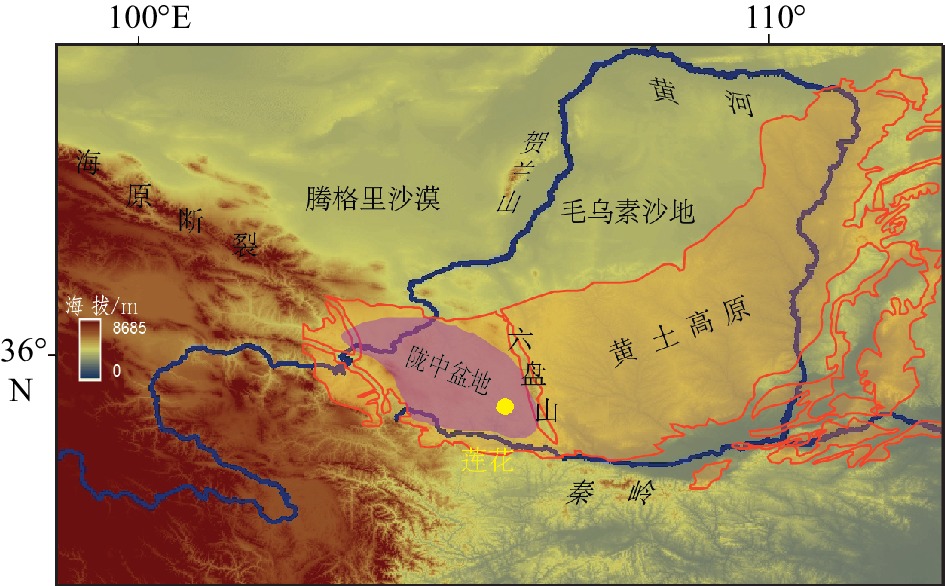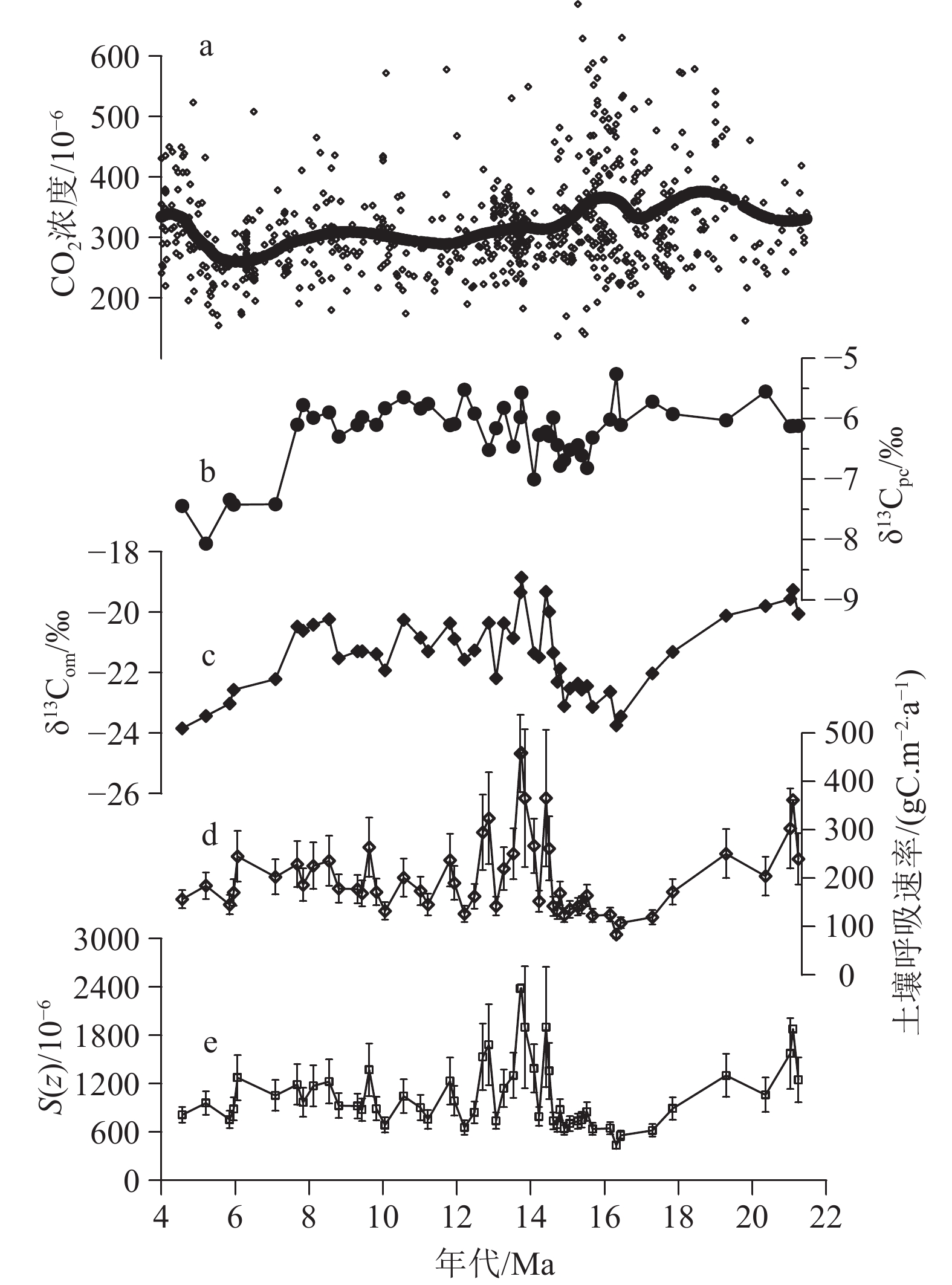Miocene soil respiration history in Longzhong Basin and its response to East Asian summer monsoon
-
摘要:
土壤呼吸作用是土壤碳循环研究的重要环节,查明呼吸作用产生的二氧化碳浓度、土壤呼吸速率及影响因素对理解土壤碳循环至关重要。目前更多的研究集中于现代土壤呼吸作用,地质历史时期的土壤呼吸报道很少。中中新世作为预测未来气候变化的相似期,其土壤呼吸的研究可以为未来高二氧化碳浓度下气候变化提供借鉴。报道了陇中盆地天水莲花剖面中新世以来碳酸盐结核的δ13CPC以及碳酸盐结核内包含的δ13Com,并重建了中新世土壤呼吸速率以及土壤呼吸释放的二氧化碳浓度。结果显示,土壤呼吸速率为150~400 gC·m−2·a−1,土壤呼吸释放的二氧化碳为700×10−6~2 400×10−6。土壤呼吸释放的二氧化碳以及土壤呼吸速率都显示在中中新世暖期增高,在早中新世及晚中新世土壤呼吸释放的二氧化碳以及土壤呼吸速率下降,这种变化与东亚夏季风降水变化趋势一致,指示暖湿气候增强了土壤呼吸作用。
Abstract:Soil respiration is an important link in the study of soil carbon cycle, for which understanding the soil respired carbon dioxide concentration, soil respiration rate, and the influencing factors is important. Most present studies focus on modern soil respiration and few concerned that in geological history. Taking the Miocene Lianhua Section, Longzhong Basin in Tianshui, Gansu, NW China as a case of an ancient analogue and as a reference point for predicting future climate change under high carbon dioxide concentration, we studied and compared the δ13C values of the organic matter in carbonate nodules (δ13Com) and that of the inorganic matter in pedogenic carbonate nodules (δ13Cpc) from the section, from which the soil respiration rate and soil respired carbon dioxide concentration during the Miocene were reconstructed. Results show that the soil respiration rate ranged 150~400 gC·m−2·a−1 and the carbon dioxide released from soil respiration ranged (700~2400)×10−6. Both soil respired CO2 and soil respiration rate were shown increased during the Middle Miocene warm period, and the soil respired CO2 and soil respiration rate decreased before and after the Middle Miocene. This change is consistent with the East Asian summer precipitation, indicating that warm-wet climate enhanced soil respiration.
-
Key words:
- Miocene /
- soil respiration /
- paleosol carbonate CO2 biometer /
- Loess plateau
-

-
[1] Raich J W, Potter C S. Global patterns of carbon dioxide emissions from soils [J]. Global Biogeochemical Cycles, 1995, 9(1): 23-36. doi: 10.1029/94GB02723
[2] Zhao Z Y, Peng C H, Yang Q, et al. Model prediction of biome-specific global soil respiration from 1960 to 2012 [J]. Earth's Future, 2017, 5(7): 715-729. doi: 10.1002/2016EF000480
[3] Carey J C, Tang J W, Templer P H, et al. Temperature response of soil respiration largely unaltered with experimental warming [J]. Proceedings of the National Academy of Sciences of the United States of America, 2016, 113(48): 13797-13802. doi: 10.1073/pnas.1605365113
[4] Jian J S, Steele M K, Day S D, et al. Future global soil respiration rates will swell despite regional decreases in temperature sensitivity caused by rising temperature [J]. Earth’s Future, 2018, 6(11): 1539-1554. doi: 10.1029/2018EF000937
[5] Cerling T E. The stable isotopic composition of modern soil carbonate and its relationship to climate [J]. Earth and Planetary Science Letters, 1984, 71(2): 229-240. doi: 10.1016/0012-821X(84)90089-X
[6] 刘强, 刘嘉麒, 刘东生. 北京斋堂黄土剖面主要温室气体组分初步研究[J]. 地质地球化学, 2000, 28(2):82-86 doi: 10.3969/j.issn.1672-9250.2000.02.013
LIU Qiang, LIU Jiaqi, LIU Dongsheng. Primary research on major greenhouse gases in Zhaitang loess section, Beijing [J]. Geology-Geochemistry, 2000, 28(2): 82-86. doi: 10.3969/j.issn.1672-9250.2000.02.013
[7] 刘嘉麒, 钟华, 刘东生. 渭南黄土中温室气体组分的初步研究[J]. 科学通报, 1997, 42(11):921-924 doi: 10.1007/BF02882548
LIU Jiaqi, ZHONG Hua, LIU Dongsheng. Preliminary study of greenhouse gases in loess in Weinan, Shaanxi province [J]. Chinese Science Bulletin, 1997, 42(11): 921-924. doi: 10.1007/BF02882548
[8] 刘强, 刘嘉麒, 隋淑珍. 山西黄土中主要温室气体组分特征[J]. 科学通报, 2001, 46(17):1469-1471 doi: 10.3321/j.issn:0023-074X.2001.08.014
LIU Qiang, LIU Jiaqi, SUI Shuzhen. Features of major greenhouse gases in loess, Shanxi Province, China [J]. Chinese Science Bulletin, 2001, 46(17): 1469-1471. doi: 10.3321/j.issn:0023-074X.2001.08.014
[9] 李艳花, 赵景波. 西安南郊不同人工植被下土壤CO2浓度研究[J]. 中国沙漠, 2006, 26(6):910-914 doi: 10.3321/j.issn:1000-694X.2006.06.008
LI Yanhua, ZHAO Jingbo. Soil CO2 Concentration under different artificial vegetations in South Suburb of Xi’an [J]. Journal of Desert Research, 2006, 26(6): 910-914. doi: 10.3321/j.issn:1000-694X.2006.06.008
[10] 宋超, 韩贵琳, 宁卓, 等. 黄土塬区包气带土壤CO2的特征及成因[J]. 第四纪研究, 2017, 37(6):1172-1181 doi: 10.11928/j.issn.1001-7410.2017.06.02
SONG Chao, HAN Guilin, NING Zhuo, et al. The characteristics and origin of CO2 in unsaturated zone at loess tableland of Northwestern China [J]. Quaternary Sciences, 2017, 37(6): 1172-1181. doi: 10.11928/j.issn.1001-7410.2017.06.02
[11] Huth T E, Cerling T E, Marchetti D W, et al. Seasonal bias in soil carbonate Formation and its implications for interpreting high-resolution paleoarchives: evidence from southern Utah [J]. Journal of Geophysical Research:Biogeosciences, 2019, 124(3): 616-632. doi: 10.1029/2018JG004496
[12] Ji S C, Ma L, Nie J S, et al. Quantifying soil-respired CO2 on the Chinese Loess Plateau [J]. Palaeogeography, Palaeoclimatology, Palaeoecology, 2021, 562: 110158. doi: 10.1016/j.palaeo.2020.110158
[13] Da J W, Zhang Y G, Li G, et al. Aridity-driven decoupling of δ13C between pedogenic carbonate and soil organic matter [J]. Geology, 2020, 48(10): 981-985. doi: 10.1130/G47241.1
[14] Da J W, Zhang Y G, Li G, et al. Low CO2 levels of the entire Pleistocene Epoch [J]. Nature Communications, 2019, 10(1): 4342. doi: 10.1038/s41467-019-12357-5
[15] Gulbranson E L, Tabor N J, Montañez I P. A pedogenic goethite record of soil CO2 variations as a response to soil moisture content [J]. Geochimica et Cosmochimica Acta, 2011, 75(22): 7099-7116. doi: 10.1016/j.gca.2011.09.026
[16] Caves Rugenstein J K, Chamberlain C P. The evolution of hydroclimate in Asia over the Cenozoic: A stable-isotope perspective [J]. Earth-Science Reviews, 2018, 185: 1129-1156. doi: 10.1016/j.earscirev.2018.09.003
[17] Licht A, Dupont-Nivet G, Meijer N, et al. Decline of soil respiration in northeastern Xizang through the transition into the Oligocene icehouse [J]. Palaeogeography, Palaeoclimatology, Palaeoecology, 2020, 560: 110016. doi: 10.1016/j.palaeo.2020.110016
[18] Hao Q Z, Guo Z T. Magnetostratigraphy of a Late Miocene-Pliocene loess-soil sequence in the western Loess Plateau in China [J]. Geophysical Research Letters, 2004, 31(9): L09209. doi: 10.1029/2003GL019392
[19] Guo Z T, Ruddiman W F, Hao Q Z, et al. Onset of Asian desertification by 22 Myr ago inferred from loess deposits in China [J]. Nature, 2002, 416(6877): 159-163. doi: 10.1038/416159a
[20] Hao Q Z, Guo Z T. Magnetostratigraphy of an early-Middle Miocene loess-soil sequence in the western Loess Plateau of China [J]. Geophysical Research Letters, 2007, 34(18): L18305. doi: 10.1029/2007gl031162
[21] Qiang X K, An Z S, Song Y G, et al. New eolian red clay sequence on the western Chinese Loess Plateau linked to onset of Asian desertification about 25 Ma ago [J]. Science China Earth Science, 2011, 54(1): 136-144. doi: 10.1007/s11430-010-4126-5
[22] 马龙. 黄土高原风尘沉积中钙结核的形态学和地球化学研究[D]. 中国科学院大学博士学位论文, 2017
MA Long. Morphological and geochemical characteristics of carbonate nodules in Aeolian deposits on Chinese loess Plateau[D]. Doctor Dissertation of University of Chinese Academy of Sciences, 2017.
[23] Cerling T E. Stable carbon isotopes in palaeosol carbonates[M]//Thiry M, Simon-Coinçon R. Palaeoweathering, Palaeosurfaces and Related Continental Deposits. Oxford: The International Association of Sedimentologists, 2000: 43-60.
[24] Torn M S, Lapenis A G, Timofeev A, et al. Organic carbon and carbon isotopes in modern and 100-year-old-soil archives of the Russian steppe [J]. Global Change Biology, 2002, 8(10): 941-953. doi: 10.1046/j.1365-2486.2002.00477.x
[25] Breecker D O, Sharp Z D, McFadden L D. Seasonal bias in the Formation and stable isotopic composition of pedogenic carbonate in modern soils from central New Mexico, USA [J]. GSA Bulletin, 2009, 121(3-4): 630-640. doi: 10.1130/B26413.1
[26] Wang K X, Lu H Y, Garzione C N, et al. Enhanced soil respiration, vegetation and monsoon precipitation at Lantian, East Asia during Pliocene warmth[J]. Climate Dynamics, 2022,doi: 10.1007/s00382-022-06243-y.
[27] Tipple B J, Meyers S R, Pagani M. Carbon isotope ratio of Cenozoic CO2: a comparative evaluation of available geochemical proxies [J]. Paleoceanography, 2010, 25(3): PA3202. doi: 10.1029/PA001851
[28] Romanek C S, Grossman E L, Morse J W. Carbon isotopic fractionation in synthetic aragonite and calcite: effects of temperature and precipitation rate [J]. Geochimica et Cosmochimica Acta, 1992, 56(1): 419-430. doi: 10.1016/0016-7037(92)90142-6
[29] Cerling T E, Quade J. Stable carbon and oxygen isotopes in soil carbonates[M]//Swart P K, Lohmann K C, Mckenzie J, et al. Climate Change in Continental Isotopic Records. Washington, DC: American Geophysical Union (AGU), 1993, 78: 217-231.
[30] Caves J K, Moragne D Y, Ibarra D E, et al. The Neogene de-greening of Central Asia [J]. Geology, 2016, 44(11): 887-890. doi: 10.1130/G38267.1
[31] 达佳伟. 基于黄土高原成壤碳酸盐的古大气二氧化碳浓度定量重建研究[D]. 南京大学博士学位论文, 2020.
DA Jiawei. Quantitative reconstruction of paleoatmospheric CO2 levels using pedogenic carbonates from the Chinese Loess Plateau[D]. Doctor Dissertation of Nanjing University, 2020.
[32] Breecker D O, Sharp Z, McFadden L. Atmospheric CO2 concentrations during ancient greenhouse climates were similar to those predicted for AD 2100 [J]. Proceedings of the National Academy of Sciences of the United States of America, 2010, 107(2): 576-580. doi: 10.1073/pnas.0902323106
[33] Cui Y, Schubert B A, Jahren A H. A 23 Ma record of low atmospheric CO2 [J]. Geology, 2020, 48(9): 888-892. doi: 10.1130/G47681.1
[34] Cerling T E. Development of grasslands and savannas in East Africa during the Neogene [J]. Palaeogeography, Palaeoclimatology, Palaeoecology, 1992, 97(3): 241-247. doi: 10.1016/0031-0182(92)90211-M
[35] Ekart D D, Cerling T E, Montanez I P, et al. A 400 million year carbon isotope record of pedogenic carbonate; implications for paleoatomospheric carbon dioxide [J]. American Journal of Science, 1999, 299(10): 805-827. doi: 10.2475/ajs.299.10.805
[36] Caldwell M M, White R S, Moore R T, et al. Carbon balance, productivity, and water use of cold-winter desert shrub communities dominated by C3 and C4 species [J]. Oecologia, 1977, 29(4): 275-300. doi: 10.1007/BF00345803
[37] De Jong E. Soil aeration as affected by slope position and vegetative cover [J]. Soil Science, 1981, 131(1): 34-43. doi: 10.1097/00010694-198101000-00006
[38] Quade J, Eiler J, Daëron M, et al. The clumped isotope geothermometer in soil and paleosol carbonate [J]. Geochimica et Cosmochimica Acta, 2013, 105: 92-107. doi: 10.1016/j.gca.2012.11.031
[39] Yang S L, Ding Z L, Li Y Y, et al. Warming-induced northwestward migration of the east Asian monsoon rain belt from the last glacial maximum to the mid-Holocene [J]. Proceedings of the National Academy of Sciences of the United States of America, 2015, 112(43): 13178-13183. doi: 10.1073/pnas.1504688112
[40] Hough B G, Fan M J, Passey B H. Calibration of the clumped isotope geothermometer in soil carbonate in Wyoming and Nebraska, USA: Implications for paleoelevation and paleoclimate reconstruction [J]. Earth and Planetary Science Letters, 2014, 391: 110-120. doi: 10.1016/j.jpgl.2014.01.008
[41] Schubert B A, Jahren A H. The effect of atmospheric CO2 concentration on carbon isotope fractionation in C3 land plants [J]. Geochimica et Cosmochimica Acta, 2012, 96: 29-43. doi: 10.1016/j.gca.2012.08.003
[42] Schubert B A, Jahren A H. Global increase in plant carbon isotope fractionation following the Last Glacial Maximum caused by increase in atmospheric pCO2 [J]. Geology, 2015, 43(5): 435-438. doi: 10.1130/G36467.1
[43] Ji S C, Nie J S, Lechler A, et al. A symmetrical CO2 peak and asymmetrical climate change during the Middle Miocene [J]. Earth and Planetary Science Letters, 2018, 499: 134-144. doi: 10.1016/j.jpgl.2018.07.011
[44] Luo Y Q, Zhou X H. Soil Respiration and the Environment[M]. Oxford: Academic Press, 2010.
[45] Bond-Lamberty B, Thomson A. A global database of soil respiration data [J]. Biogeosciences, 2010, 7(6): 1915-1926. doi: 10.5194/bg-7-1915-2010
[46] Hui Z C, Li J J, Xu Q H, et al. Miocene vegetation and climatic changes reconstructed from a sporopollen record of the Tianshui Basin, NE Xizang Plateau [J]. Palaeogeography, Palaeoclimatology, Palaeoecology, 2011, 308(3-4): 373-382. doi: 10.1016/j.palaeo.2011.05.043
[47] Song Y G, Wang Q S, An Z S, et al. Mid-Miocene climatic optimum: Clay mineral evidence from the red clay succession, Longzhong Basin, Northern China [J]. Palaeogeography, Palaeoclimatology, Palaeoecology, 2018, 512: 46-55. doi: 10.1016/j.palaeo.2017.10.001
[48] Clift P D, Wan S M, Blusztajn J. Reconstructing chemical weathering, physical erosion and monsoon intensity since 25 Ma in the northern South China Sea: A review of competing proxies [J]. Earth-Science Reviews, 2014, 130: 86-102. doi: 10.1016/j.earscirev.2014.01.002
-




 下载:
下载:

